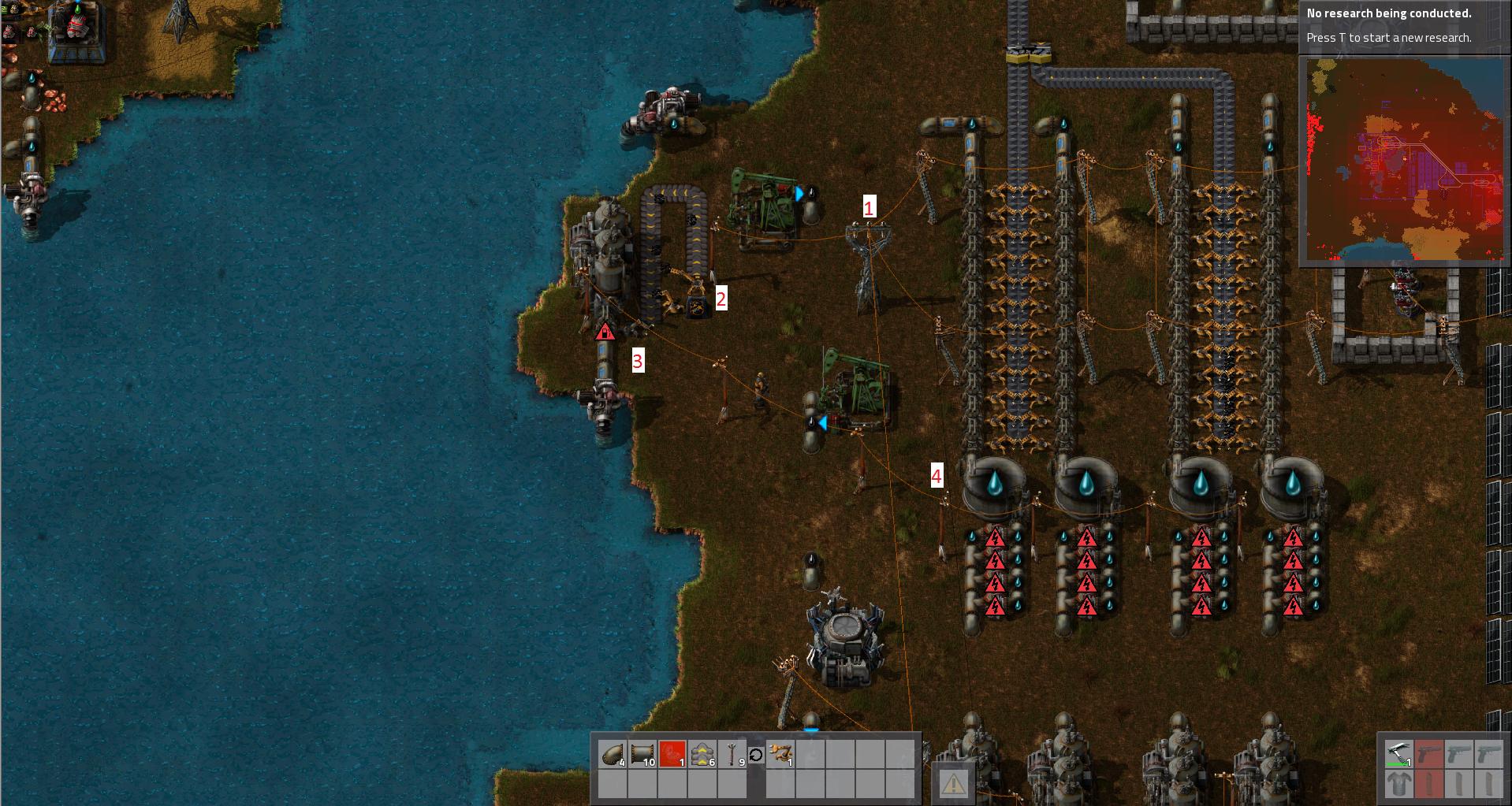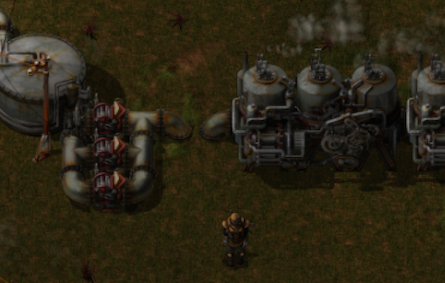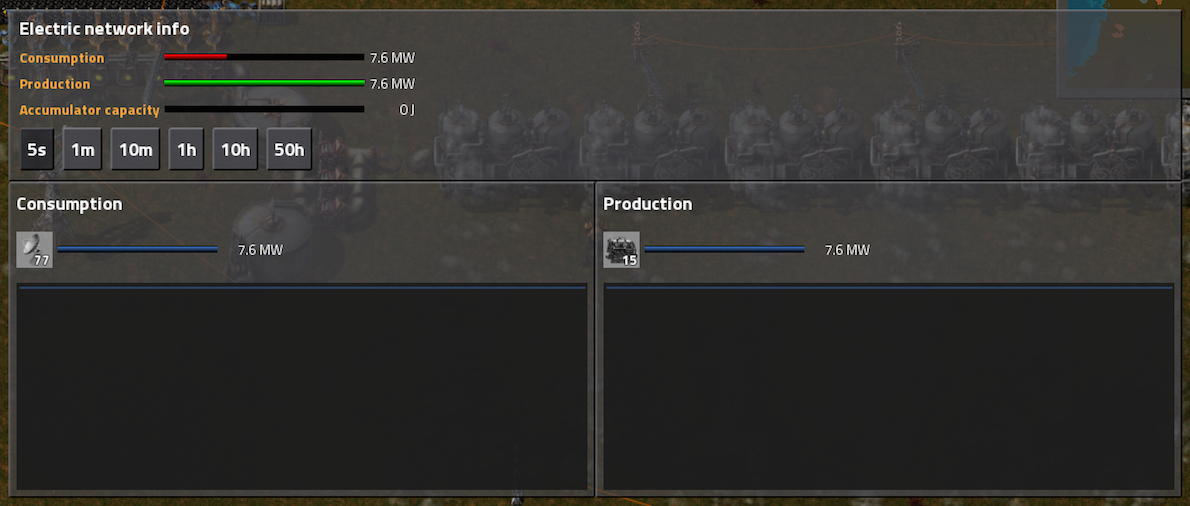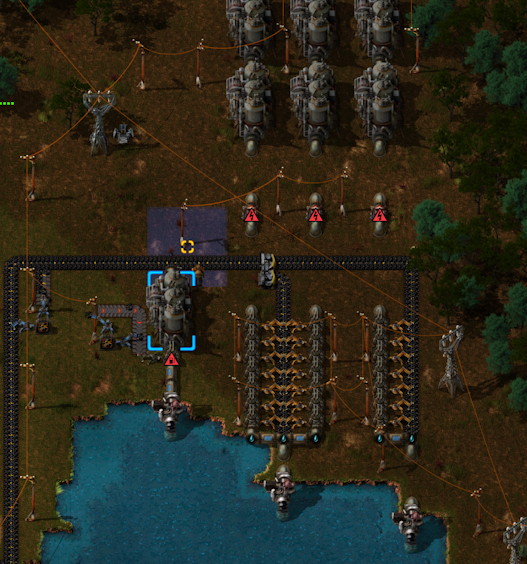My take on using steam as a backup. Works perfectly for me.
Posted: Thu Nov 13, 2014 10:47 pm
Instant response, instant cutoff, configurable run duration, no red/green wiring, easily scalable.
Before starting, I'll say that this design is inspired by a post on the forums by User_Name.
https://forums.factorio.com/forum/viewtop ... f=8&t=6617
Okay so this screenshot has all the important parts visible. Ignore the roboports, pump jacks, and turrets.
http://i.imgur.com/KXp0EIp.jpg

I'll go through it according to the numbers in the picture:
1.) This line is connected to the main power system in the factory. Notice that the wires DO NOT touch the line of small power poles below. I'll get back to that. In my system, there are 4 steam lines with 12 boilers and 15 steam generators each. You can scale as needed.
2.) This is the detection area. There is a requester chest which always has a stack of fuel in it (coal in this case). These arms are powered by the main grid. The upper inserter takes fuel out of the chest, while the lower inserter puts it back in. While the system has power, both arms work constantly and so no fuel gets past the 2nd inserter. In the case of power failure, the arms start to stutter and the fuel already on the conveyor belt moves past the second arm.
3.) A little hard to see, but this is a burner inserter; it has to be, because it needs to be independent of all electrical sources. It is filled with a stack of solid fuel and only runs in case of emergency so it will never run out of fuel. In case of power failure, fuel from the conveyor moves within its range and gets put into the boiler behind it, powering the single steam engine.
4.) This power line is powered ONLY by the single steam engine on the left, not by the main electrical system of the plant. This means that it is only powered when the system has detected a power outage. The ONLY things powered by this line are the pumps below each water tank. During regular operation, the pumps are not powered and therefore no water flows through them, and so the steam system is not operational. When these are powered, hot water is delivered to the steam engines and they turn on. (Small note in case it's not obvious: all the small pumps are facing left)
Important note on setting it up: Because the wiring has to be a specific way, you may have to wire part of it up manually. You can do this by shift-clicking a power pole, which removes all its connections. You can then craft copper cable and manually wire each pole to where it's supposed to go.
Changing output/adding capacity: You can easily adjust the number of burners or steam generators in each line, or add whole new lines to suit your power needs. Add pumps as needed to get enough water flow.
Holding tanks: The tanks hold a large amount of hot water, ready to go. Because your steam system is (in theory, at least) running only for small periods, you can get away with installing fewer boilers than you'd normally need. Even in the worst case scenario, you should have all day to fill your tanks up with hot water while the solar panels supply electricity. The tanks should last more than one full night.
Run time: So basically, this system will run for a certain amount of time and then turn itself off. If main power is still not restored, it'll turn on again and keep cycling until your power issues have been resolved. The amount of time that it runs can be adjusted at area (2) in the picture. You can adjust the type of fuel you're using (wood, coal, or solid fuel); a longer burning fuel will run the system longer. You can also increase the length of the belt between the two arms. A longer belt would have more fuel on it when power fails, and therefore let the emergency system run longer. You can also change these two arms to fast inserters to have the same effect as increasing belt length. Generally, you would want this system to run for a long time because you will need to ensure your factory is running smoothly until the issue is resolved, while hopefully recharging your accumulators enough to deal with potential laser turret usage.
With my exact setup, it provides 30 MW power and runs long enough to last the night when solar panels aren't online. It will run at full 30 MW power for at least two nights before the storage tanks run out, and at then it runs at 17 MW continuously.
Before starting, I'll say that this design is inspired by a post on the forums by User_Name.
https://forums.factorio.com/forum/viewtop ... f=8&t=6617
Okay so this screenshot has all the important parts visible. Ignore the roboports, pump jacks, and turrets.
http://i.imgur.com/KXp0EIp.jpg

I'll go through it according to the numbers in the picture:
1.) This line is connected to the main power system in the factory. Notice that the wires DO NOT touch the line of small power poles below. I'll get back to that. In my system, there are 4 steam lines with 12 boilers and 15 steam generators each. You can scale as needed.
2.) This is the detection area. There is a requester chest which always has a stack of fuel in it (coal in this case). These arms are powered by the main grid. The upper inserter takes fuel out of the chest, while the lower inserter puts it back in. While the system has power, both arms work constantly and so no fuel gets past the 2nd inserter. In the case of power failure, the arms start to stutter and the fuel already on the conveyor belt moves past the second arm.
3.) A little hard to see, but this is a burner inserter; it has to be, because it needs to be independent of all electrical sources. It is filled with a stack of solid fuel and only runs in case of emergency so it will never run out of fuel. In case of power failure, fuel from the conveyor moves within its range and gets put into the boiler behind it, powering the single steam engine.
4.) This power line is powered ONLY by the single steam engine on the left, not by the main electrical system of the plant. This means that it is only powered when the system has detected a power outage. The ONLY things powered by this line are the pumps below each water tank. During regular operation, the pumps are not powered and therefore no water flows through them, and so the steam system is not operational. When these are powered, hot water is delivered to the steam engines and they turn on. (Small note in case it's not obvious: all the small pumps are facing left)
Important note on setting it up: Because the wiring has to be a specific way, you may have to wire part of it up manually. You can do this by shift-clicking a power pole, which removes all its connections. You can then craft copper cable and manually wire each pole to where it's supposed to go.
Changing output/adding capacity: You can easily adjust the number of burners or steam generators in each line, or add whole new lines to suit your power needs. Add pumps as needed to get enough water flow.
Holding tanks: The tanks hold a large amount of hot water, ready to go. Because your steam system is (in theory, at least) running only for small periods, you can get away with installing fewer boilers than you'd normally need. Even in the worst case scenario, you should have all day to fill your tanks up with hot water while the solar panels supply electricity. The tanks should last more than one full night.
Run time: So basically, this system will run for a certain amount of time and then turn itself off. If main power is still not restored, it'll turn on again and keep cycling until your power issues have been resolved. The amount of time that it runs can be adjusted at area (2) in the picture. You can adjust the type of fuel you're using (wood, coal, or solid fuel); a longer burning fuel will run the system longer. You can also increase the length of the belt between the two arms. A longer belt would have more fuel on it when power fails, and therefore let the emergency system run longer. You can also change these two arms to fast inserters to have the same effect as increasing belt length. Generally, you would want this system to run for a long time because you will need to ensure your factory is running smoothly until the issue is resolved, while hopefully recharging your accumulators enough to deal with potential laser turret usage.
With my exact setup, it provides 30 MW power and runs long enough to last the night when solar panels aren't online. It will run at full 30 MW power for at least two nights before the storage tanks run out, and at then it runs at 17 MW continuously.


